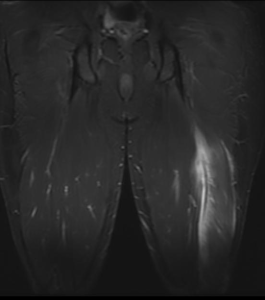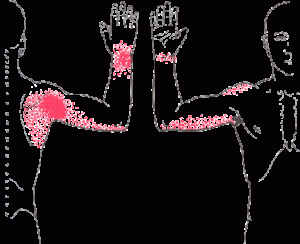Many sports physiotherapists rehabilitate hamstring injuries on a daily basis. Unfortunately, they can be very tricky to fully and definitively rehabilitate fully and reported re-injury rates are as high as 50%. This statistic inevitably leads to the people screaming it is due to inadequate rehabilitation techniques, which may be correct. Accordingly, this article will discuss new research which compares the clinical and morphological effects of 2 effective rehabilitation programs for hamstring injuries.
Lateral epicondylalgia (tennis elbow) is a condition that I, and am sure many other physiotherapists out there, treat very commonly. Interestingly, despite the frequency with which healthcare is sought for this condition; only recently has our understanding of the pathophysiology of lateral elbow overuse injury improved. Consequently, the treatment approaches for lateral epicondylalgia vary widely and lack definitive evidence. Therefore, this article will discuss the evidence based assessment and management of lateral epicondylalgia (tennis elbow)…
It is no secret that sports physiotherapists and physical therapists across the world commonly assess and treat knee injuries. Of these injuries, patellofemoral pain is exceptionally common, accounting for 25% of all sports related knee injuries (Fredericson & Yoon, 2006). In fact, patellofemoral pain syndrome is the most commonly reported injury sustained by runners (Taunton et al., 2002). As many of the aetiological factors that contribute to patellofemoral pain syndrome have not been clearly identified, decision making regarding appropriate rehabilitation and treatment can often be challenging. This article will discuss the use of isometric adduction during closed kinetic chain lower limb exercises to facilitate vastus medialis obliquus (VMO) activation.
Patellofemoral pain syndrome is a condition that is commonly encountered by the sports physiotherapist. There is a clear reason for this, it has been reported to affect approximately 25% of athletes (DeHaven & Lintner, 1986). Furthermore, it is the most commonly reported injury sustained by runners (Taunton et al., 2002). Thus, it is the subject of much discussion on this site, and we have provided articles on a number of management options for patellofemoral pain syndrome. However, this article will discuss new research on potential prospective indicators for the development of patellofemoral pain syndrome.
We all know that hamstring strains are common injuries within sports that involve sprinting and jumping. In fact, they represent a significant proportion of muscle injuries: 50% in sprinting, 40% in soccer (Yeung et al, 2009) and 14% in Australian Rules football (Gabbe et al, 2006). They have been shown to be more common than any other muscle injuries and players are 2.5 times more likely to suffer a hamstring strain compared to a strain of their quadriceps (Woods et al, 2004). This is significant as Small et al (2010) found that soccer players miss on average 3 competitive matches per hamstring injury. Consider the huge impact on the success of sporting teams when high profile players are injured!
As sports physiotherapists we regularly assess and treat hamstring strains, sometimes on a daily basis! Hawkins et al. (2001) showed that hamstring injuries accounted for approximately 12% of football injuries, and thus are extremely common. Given their frequency, hamstring injuries have been discussed commonly on this site. However, to date, we have not paid much attention to the often recommended intervention of spinal manual therapy and its role in the evidence based management of hamstring strains….
Shoulder injuries to the rotator cuff are very common. Whilst rotator cuff injuries are more commonly seen in supraspinatus and infraspinatus, there has been a recent increase in awareness and recognition of subscapularis injuries. In fact, Barth et al. (2006) suggested 29.4% of those who underwent shoulder arthroscopy for a rotator cuff tear had involvement of the subscapularis. Therefore, a thorough understanding of the evidence based clinical assessment for subscapularis is essential, and is thus presented in this article.
Let me set the scene for you. You are at the oval and your athletes are warming up prior to competition, and one calls out “can you come stretch my hammys?”. This is an obvious request for a PNF therapist-assisted stretch, and you will likely oblige for a few reasons. Today I would like to discuss some research that challenges the notion that PNF stretching deliver superior immediate improvements in range of motion..
As most sports physiotherapists would know, injuries of the groin are very common. This is particularly true in sports that require lateral movements and kicking; think football, rugby and AFL. In fact in some sports the incidence of groin pain is as high as 13%. This means that we are regularly assessing groin pathologies, and should be aware of the most effective and reliable techniques to assess deficits in adductor function. This article will discuss new research on the Adductor Squeeze Test that can inform and improve your clinical practice…
It will come as no surprise to anybody that we are in the business of treating soft tissues injuries. If this is a surprise.. stand up and walk away from the screen now … this information or website is not for you! But for the majority of physiotherapists who treat acute soft tissue sports injuries we will base our early interventions around the PRICE principle (protection, relative rest, ice, compression, elevation). This would be considered a component of gold-standard management…
In the past this site has featured some lighter, colloquial blog posts. These articles discuss issues related to the greater physiotherapy community. Thus, I present a few mantras I have heard, adapted or made up for the physios to live by in the coming year.
Radial tunnel syndrome is rare, it is challenging to differentially diagnose and can be a monster to manage. If you have a recalcitrant case of tennis elbow then this post will interest you! This article discusses the best available evidence for assessment and management of radial tunnel syndrome.








